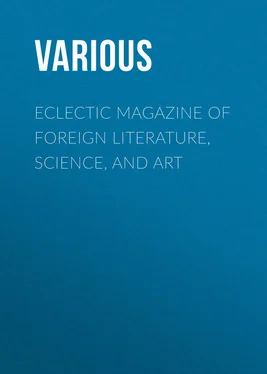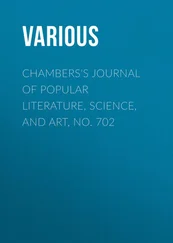Various - Eclectic Magazine of Foreign Literature, Science, and Art
Здесь есть возможность читать онлайн «Various - Eclectic Magazine of Foreign Literature, Science, and Art» — ознакомительный отрывок электронной книги совершенно бесплатно, а после прочтения отрывка купить полную версию. В некоторых случаях можно слушать аудио, скачать через торрент в формате fb2 и присутствует краткое содержание. Жанр: foreign_home, на английском языке. Описание произведения, (предисловие) а так же отзывы посетителей доступны на портале библиотеки ЛибКат.
- Название:Eclectic Magazine of Foreign Literature, Science, and Art
- Автор:
- Жанр:
- Год:неизвестен
- ISBN:нет данных
- Рейтинг книги:4 / 5. Голосов: 1
-
Избранное:Добавить в избранное
- Отзывы:
-
Ваша оценка:
- 80
- 1
- 2
- 3
- 4
- 5
Eclectic Magazine of Foreign Literature, Science, and Art: краткое содержание, описание и аннотация
Предлагаем к чтению аннотацию, описание, краткое содержание или предисловие (зависит от того, что написал сам автор книги «Eclectic Magazine of Foreign Literature, Science, and Art»). Если вы не нашли необходимую информацию о книге — напишите в комментариях, мы постараемся отыскать её.
Eclectic Magazine of Foreign Literature, Science, and Art — читать онлайн ознакомительный отрывок
Ниже представлен текст книги, разбитый по страницам. Система сохранения места последней прочитанной страницы, позволяет с удобством читать онлайн бесплатно книгу «Eclectic Magazine of Foreign Literature, Science, and Art», без необходимости каждый раз заново искать на чём Вы остановились. Поставьте закладку, и сможете в любой момент перейти на страницу, на которой закончили чтение.
Интервал:
Закладка:
The lustre of the milky way and zodiacal light at this elevated station was indescribable, and Jupiter shone with extraordinary splendor. Nevertheless, not even the most fugitive glimpse of any of his satellites was to be had without optical aid. 11 11 We are told that three American observers in the Rocky Mountains, belonging to the Eclipse Expedition of 1878, easily saw Jupiter’s satellites night after night with the naked eye. That their discernment is possible, even under comparatively disadvantageous circumstances is rendered certain by the well-authenticated instance (related by Humboldt, “Cosmos,” vol. iii. p. 66, Otte’s trans.) of a tailor named Schön, who died at Breslau in 1837. This man habitually perceived the first and third, but never could see the second or fourth Jovian moons.
This was possibly attributable to the prevalent “dust-haze”, which must have caused a diffusion of light in the neighborhood of the planet more than sufficient to blot from sight such faint objects. The same cause completely neutralized the darkening of the sky usually attendant upon ascents into the more ethereal regions, and surrounded the sun with an intense glare of reflected light. For reasons presently to be explained, this circumstance alone would render the Peak of Teneriffe wholly unfit to be the site of a modern observatory.
Within the last thirty years a remarkable change, long in preparation, 12 12 Sir W. Herschel’s great undertakings, Bessel remarks (“Populäre Vorlesungen,” p. 15), “were directed rather towards a physical description of the heavens, than to astronomy proper.”
has conspicuously affected the methods and aims of astronomy; or, rather, beside the old astronomy – the astronomy of Laplace, of Bessel, of Airy, Adams, and Leverrier – has grown up a younger science, vigorous, inspiring, seductive, revolutionary, walking with hurried or halting footsteps along paths far removed from the staid courses of its predecessor. This new science concerns itself with the nature of the heavenly bodies; the elder regarded exclusively their movements . The aim of the one is description , of the other prediction . This younger science inquires what sun, moon, stars, and nebulæ are made of, what stores of heat they possess, what changes are in progress within their substance, what vicissitudes they have undergone or are likely to undergo. The elder has attained its object when the theory of celestial motions shows no discrepancy with fact – when the calculus can be brought to agree perfectly with the telescope – when the coursers of the heavens come strictly up to time, and their observed places square to a hair’s-breadth with their predicted places.
It is evident that very different modes of investigation must be employed to further such different objects; in fact, the invention of novel modes of investigation has had a prime share in bringing about the change in question. Geometrical astronomy, or the astronomy of position, seeks above all to measure with exactness, and is thus more fundamentally interested in the accurate division and accurate centering of circles than in the development of optical appliances. Descriptive astronomy, on the other hand, seeks as the first condition of its existence to see clearly and fully. It has no “method of least squares” for making the best of bad observations – no process for eliminating errors by their multiplication in opposite directions; it is wholly dependent for its data on the quantity and quality of the rays focussed by its telescopes, sifted by its spectroscopes, or printed in its photographic cameras. Therefore, the loss and disturbance suffered by those rays in traversing our atmosphere constitute an obstacle to progress far more serious now than when the exact determination of places was the primary and all-important task of an astronomical observer. This obstacle, which no ingenuity can avail to remove, may be reduced to less formidable dimensions. It may be diminished or partially evaded by anticipating the most detrimental part of the atmospheric transit – by carrying our instruments upwards into a finer air – by meeting the light upon the mountains.
The study of the sun’s composition, and of the nature of the stupendous processes by which his ample outflow of light and heat is kept up and diffused through surrounding space, has in our time separated, it might be said, into a science apart. Its pursuit is, at any rate, far too arduous to be conducted with less than a man’s whole energies; while the questions which it has addressed itself to answer are the fundamental problems of the new physical astronomy. There is, however, but one opinion as to the expediency of carrying on solar investigations at higher altitudes than have hitherto been more than temporarily available.
The spectroscope and the camera are now the chief engines of solar research. Mere telescopic observation, though always an indispensable adjunct, may be considered to have sunk into a secondary position. But the spectroscope and the camera, still more than the telescope, lie at the mercy of atmospheric vapors and undulations. The late Professor Henry Draper, of New York, an adept in the art of celestial photography, stated in 1877 that two years, during which he had photographed the moon at his observatory on the Hudson on every moonlit night, yielded only three when the air was still enough to give good results, nor even then without some unsteadiness; and Bond, of Cambridge (U. S.) informed him that he had watched in vain, through no less than seventeen years for a faultless condition of our troublesome environing medium. 13 13 Am. Jour. of Science, vol. xiii. p. 89.
Tranquillity is the first requisite for a successful astronomical photograph. The hour generally chosen for employing the sun as his own limner is, for this reason, in the early morning, before the newly emerged beams have had time to set the air in commotion, and so blur the marvellous details of his surface-structure. By this means a better definition is secured but at the expense of transparency. Both are, at the sea-level, hardly ever combined. A certain amount of haziness is the price usually paid for exceptional stillness, so that it not unfrequently happens that astronomers see best in a fog, as on the night of November 15th, 1850, when the elder Bond discovered the “dusky ring” of Saturn, although at the time no star below the fourth magnitude could be made out with the naked eye. Now on well-chosen mountain stations, a union of these unhappy divorced conditions is at certain times to be met with, opportunities being thus afforded with tolerable certainty and no great rarity, which an astronomer on the plains might think himself fortunate in securing once or twice in a lifetime.
For spectroscopic observations at the edge of the sun, on the contrary, the sine quâ non is translucency. During the great “Indian eclipse” of August 18th, 1868, the variously colored lines were, by the aid of prismatic analysis, first described, which reveal the chemical constitution of the flamelike “prominences,” forming an ever-varying, but rarely absent, feature of the solar surroundings. Immediately afterwards, M. Janssen, at Guntoor, and Mr. Norman Lockyer, in England, independently realised a method of bringing them into view without the co-operation of the eclipsing moon. This was done by fanning out with a powerfully dispersive spectroscope the diffused radiance near the sun, until it became sufficiently attenuated to permit the delicate flame-lines to appear upon its rainbow-tinted background. This mischievous radiance – which it is the chief merit of a solar eclipse to abolish during some brief moments – is due to the action of the atmosphere, and chiefly of the watery vapors contained in it. Were our earth stripped of its “cloud of all-sustaining air,” and presented, like its satellite, bare to space, the sky would appear perfectly black up to the very rim of the sun’s disc – a state of things of all others (vital necessities apart) the most desirable to spectroscopists. The best approach to its attainment is made by mounting a few thousand feet above the earth’s surface. In the drier and purer air of the mountains, “glare” notably diminishes, and the tell-tale prominence-lines are thus more easily disengaged from the effacing lustre in which they hang, as it were suspended.
Читать дальшеИнтервал:
Закладка:
Похожие книги на «Eclectic Magazine of Foreign Literature, Science, and Art»
Представляем Вашему вниманию похожие книги на «Eclectic Magazine of Foreign Literature, Science, and Art» списком для выбора. Мы отобрали схожую по названию и смыслу литературу в надежде предоставить читателям больше вариантов отыскать новые, интересные, ещё непрочитанные произведения.
Обсуждение, отзывы о книге «Eclectic Magazine of Foreign Literature, Science, and Art» и просто собственные мнения читателей. Оставьте ваши комментарии, напишите, что Вы думаете о произведении, его смысле или главных героях. Укажите что конкретно понравилось, а что нет, и почему Вы так считаете.












